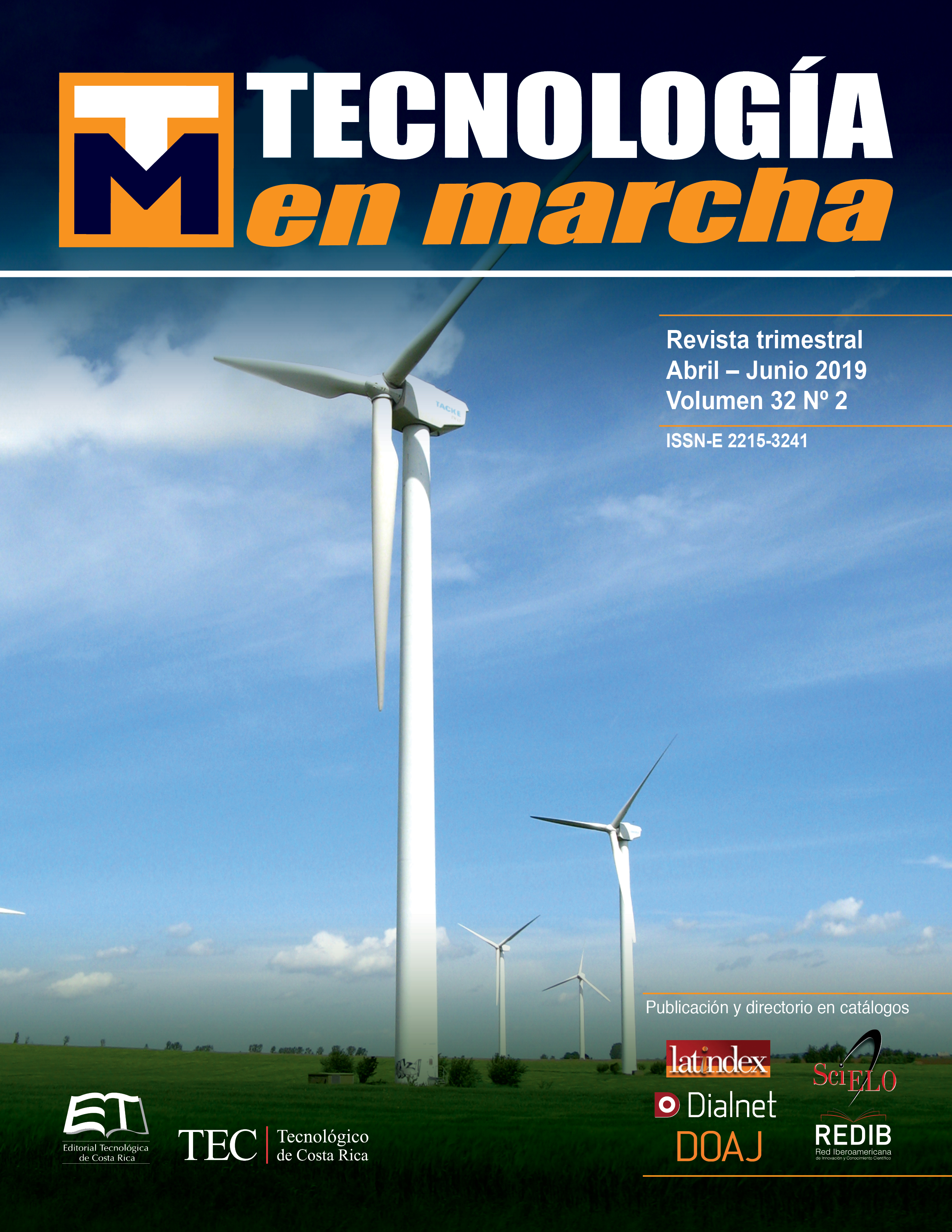Estudio experimental de la carbonatación del concreto
Contenido principal del artículo
Resumen
En el sector civil de la construcción, el concreto y el refuerzo metálico representan aun los materiales de mayor importancia, aunque sean muy vulnerables por los agentes atmosféricos, como en el caso de su degradación por corrosión. En Costa Rica, debido a la falta de métodos de monitoreo de las estructuras existentes y a una deficiente política preventiva en términos de mantenimiento, se hace urgente el desarrollo de modelos predictivos que permitan intervenir a tiempo las estructuras antes de que se comprometa de alguna forma la integridad de los usuarios. En este artículo se presentan los resultados de una investigación sobre la carbonatación por causa del gas CO2, considerando el estudio experimental de la carbonatación del concreto sin la presencia del refuerzo metálico. Se usan métodos de carbonatación en cámara acelerada bajo condiciones muy controladas, ensayos de difracción de rayos X y químicos con el propósito de verificar el avance de la profundidad de carbonatación en el tiempo. Los resultados experimentales demuestran la efectividad del proceso en la cámara de carbonatación acelerada y brindan la variación de la resistencia a compresión de los especímenes de concreto, con el avance del frente de carbonatación en el tiempo.
Detalles del artículo
Los autores conservan los derechos de autor y ceden a la revista el derecho de la primera publicación y pueda editarlo, reproducirlo, distribuirlo, exhibirlo y comunicarlo en el país y en el extranjero mediante medios impresos y electrónicos. Asimismo, asumen el compromiso sobre cualquier litigio o reclamación relacionada con derechos de propiedad intelectual, exonerando de responsabilidad a la Editorial Tecnológica de Costa Rica. Además, se establece que los autores pueden realizar otros acuerdos contractuales independientes y adicionales para la distribución no exclusiva de la versión del artículo publicado en esta revista (p. ej., incluirlo en un repositorio institucional o publicarlo en un libro) siempre que indiquen claramente que el trabajo se publicó por primera vez en esta revista.
Citas
Wang X., Nguyen M., Stewart M., Syme M. and Leitch A., Analysis of climate change impacts on the deterioration of concrete infrastructure. Part 1: Mechanisms, Practices, Modeling and Simulations - A Review, CSIRO, Canberra, 2010.
ASCE, Report card for America’s infrastructure, American Society of Civil Engineers, Reston, VA, 2013.
Morcillo M., Almeida M.E.M., Rosales B.M., Uruchurtu J. y Marrocos M., Corrosión y Protección de metales en las atmosferas en Iberoamérica-Parte 1, Programa CYTED, Madrid, 1998.
Hayden H. W., Mofatt W.G. and Wulff J., The structure and properties of materials, Vol. III Mechanical Behavior, John Wiley and Sons, New York, 1965.
Muñoz F.M., Componentes principales de las mezclas de concreto, Editorial de la Universidad de Costa Rica, San Pedro, Costa Rica, 1998.
Neville A.M., Tecnología del concreto, Instituto Mexicano del Cemento y del Concreto, Editorial Limusa, México, 1998.
ACI 318 S-14, Requisitos de Reglamento para Concreto Estructural y Comentario, American Concrete Institute, USA, 2010.
Tuutti K., Corrosion of steel in concrete, Swedish Cement and Concrete Institute RIT-Stockholm, 1982. [9] Papadakis V.G., Vayenas C.G. and Fardis M.N., A reaction engineering approach to the problem of concrete carbonation, American Inst. of Chemical Engineers, 35, N.10, 1639-1650, 1989.
Papadakis V.G., Vayenas C.G. and Fardis M.N., A reaction engineering approach to the problem of concrete carbonation, American Inst. of Chemical Engineers, 35, N.10, 1639-1650, 1989.
Papadakis V.G., Vayenas C.G. and Fardis M.N., Experimental investigation and mathematical modelling of the concrete carbonation problem, Chemical Engineering Science, 46, N.5/6, 1333-1338, 1991.
Papadakis V.G., Fardis M.N. and Vayenas C.G., Fundamental Modeling and experimental investigation of concrete carbonation, ACI Materials Journal, 88, N.4, 363-373, 1991.
Papadakis V.G., Fardis M.N. and Vayenas C.G., Hydration and carbonation of pozzolanic cement, ACI Materials Journal, 89, N.2, 119-130, 1992.
Papadakis V.G., Fardis M.N. and Vayenas C.G., Effect of composition, environmental factors and cement-lime mortar coating on concrete carbonation, Materials and Structures, 25, 293-304, 1992.
Hyvert N., Sellier A., Duprat F., Rougeau P. and Francisco P., Dependency of C-S-H carbonation rate on CO2 pressure to explain transition from accelerated tests to natural carbonation, Cement and Concrete Research, 40, 1582-1589, 2010.
Zhiguon N. and Ri Y., Experimental investigation of concrete carbonation under different conditions, Study of Civil Engineering and Architecture (SCEA), 2, N.4, 114-117, 2013.
Chi J.M., Huang R. and Yang C.C., Effects of carbonation on mechanical properties and durability of concrete using accelerated testing method, Journal of marine science and technology, 10, N.1, 14-20, 2002.
Hills T.P., Gordon F., Florin N.H. and Fennell P.S., Statistical analysis of the carbonation rate of concrete, Cement and Concrete Research, 72, 98-107, 2015.
Chávez–Ulloa E., Perez-Lopez T., Reyes-Trujeque J., Corvo-Perez F. y Osorno-Carrillo J.B., Carbonatación de concreto en atmósfera natural y cámara de carbonatación acelerada, Revista CENIC-Ciencias Químicas, 41, 2010.
Pham S. T., Experimental Investigation and Modelling of Carbonation Process in Cement Materials, The Open Civil Engineering Journal, 7, 116-125, 2013.
Talukdar S., Banthia N. and Grace J., Carbonation in concrete infrastructure in the context of global climate change- Part 1: Experimental results and model development, Cement and Concrete Composites, 34, N. 8, 924-930, 2012.
American Society for Testing and Materials, ASTM C 29 Standard Test Method for Bulk Density (“Unit Weight”) and Voids in Aggregate, 2017.
American Society for Testing and Materials, ASTM C 127: Standard Test Method for Relative Density (Specific Gravity) and Absorption of Coarse Aggregate, 2015.
American Society for Testing and Materials, ASTM C 128: Standard Test Method for Relative Density (Specific Gravity) and Absorption of Fine Aggregate, 2015.
American Society for Testing and Materials, ASTM C 136: Standard Test Method for Sieve Analysis of Fine and Coarse Aggregates, 2014.
American Society for Testing and Materials, ASTM C192: Standard Practice for Making and Curing Concrete Test Specimens in the Laboratory, 2016.

